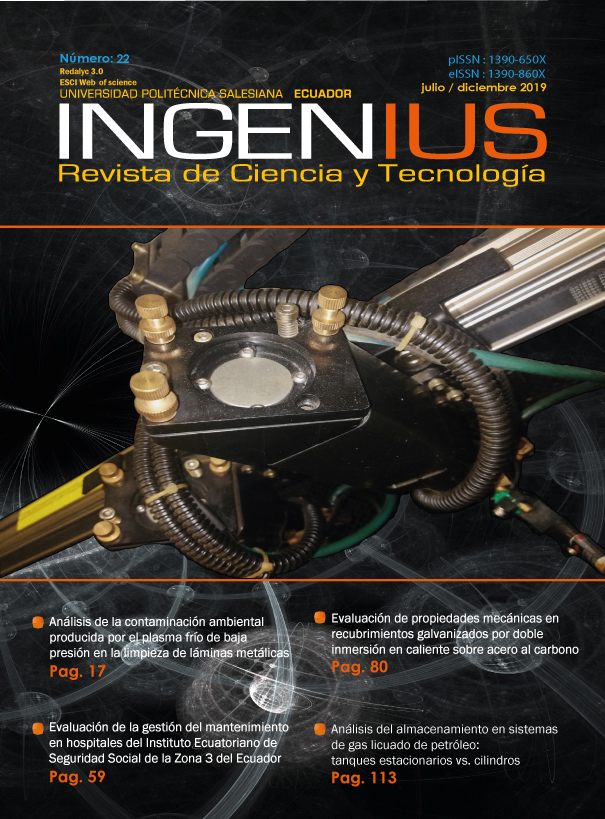Technological Innovation of a Comprehensive System to Monitor Electric Consumption
Main Article Content
Abstract
Article Details
The Universidad Politécnica Salesiana of Ecuador preserves the copyrights of the published works and will favor the reuse of the works. The works are published in the electronic edition of the journal under a Creative Commons Attribution/Noncommercial-No Derivative Works 4.0 Ecuador license: they can be copied, used, disseminated, transmitted and publicly displayed.
The undersigned author partially transfers the copyrights of this work to the Universidad Politécnica Salesiana of Ecuador for printed editions.
It is also stated that they have respected the ethical principles of research and are free from any conflict of interest. The author(s) certify that this work has not been published, nor is it under consideration for publication in any other journal or editorial work.
The author (s) are responsible for their content and have contributed to the conception, design and completion of the work, analysis and interpretation of data, and to have participated in the writing of the text and its revisions, as well as in the approval of the version which is finally referred to as an attachment.
References
[2] C. Vargas, “Sobre la problemática energética,” Comunicación.
[3] E. Menéndez Pérez, Las energías renovables: un enfoque político-ecológico. Libros de la catarata, 1997. [Online]. Available: http://bit.ly/2W11aQP
[4] F. Estenssoro Saavedra, J. M. Zolezzi Cid, M. Tokman Ramos, R. Núñez Muñoz, E. Águila Mancilla, R. Sohr Biss, C. Parker Gumucio, J. Zanelli, A. Cubillos Meza, J. A. Perrotta, J. Griffiths Spielman, I. Witker, and O. Sunkel, Energía y medio ambiente. Una ecuación difícil para América Latina: los desafíos del crecimiento y desarrollo en el contexto del cambio climático, IDEA-USACH, Ed. Colección Idea, 2011. [Online]. Available: http://bit.ly/2EjGuJW
[5] INEC, Módulo de Información Ambiental en Hogares. Instituto Nacional de Estadísticas y Censos, Ecuador, 2017. [Online]. Available: http://bit.ly/2VW77zy
[6] M. J. Mnati, A. Van den Bossche, and R. F. Chisab, “A smart voltage and current monitoring system for three phase inverters using an android smartphone application,” Sensors, vol. 17, no. 4, 2017. [Online]. Available: http://bit.ly/2WSHQCw
[7] NOAO, “Guía para el cálculo de energía,” National Optical Astronomy Observatory, Tech. Rep., 2016. [Online]. Available: http://bit.ly/2YEnkWY
[8] W. McAllister, Divisor de voltaje. Khan Academy, 2019. [Online]. Available: http://bit.ly/2LSNyDj
[9] L. Burwell. (2019) ¿Qué es un detector de cruce por cero? Techlandia. [Online]. Available: http://bit.ly/2LY5uwt
[10] A. Pilicita and D. Cevallos, Diseño y complementación de un prototipo para el monitoreo remoto del consumo eléctrico a través de una red Zigbee con médulos Xbee, S.-E. Universidad de las Fuerzas Armadas-ESPE, Ed. Proyecto de titulación, 2014.
[11] MICROCHIP, “Pic12(l)f1840 data sheet,” Microchip Technology Inc., Tech. Rep., 2019. [Online]. Available: http://bit.ly/2QcR9L4
[12] DIGI, “DIGI XBEE®S2C 802.15.4 RF MODULES,” Digi International Inc., Tech. Rep., 2019. [Online]. Available: http://bit.ly/2wbCtTq
[13] ZOLL, Manual del usuario de la unidad X Series ®, ZOLL Medical Corporation, 2016. [Online]. Available: http://bit.ly/2M0hAoI
[14] I. Vidri Salgado, ZigBee y sus aplicaciones. Escuela Técnica Superior de Ingeniería-ICAI. Universidad Pontificia Comillas, 2011. [Online].
Available: http://bit.ly/30wH0gV
[15] IEEE, IEEE 802.15.4-2015 - IEEE Standard for Low-Rate Wireless Networks, IEEE standards association Std., 2015. [Online]. Available: http://bit.ly/2LXR2V9
[16] Interactivo, Xbee y arduino, 2016. [Online]. Available: http://bit.ly/2QfP29b
[17] A. Lozada. (2018) Las etapas del diseño de una correcta base de datos relacional. EDteam. [Online]. Available: http://bit.ly/2waK9oN
[18] Hostname, Servidor Web. Servicio Informáticos Hostname Limitada, 2014. [Online]. Available: http://bit.ly/2LWDLfz

